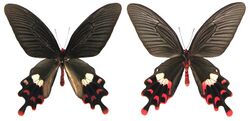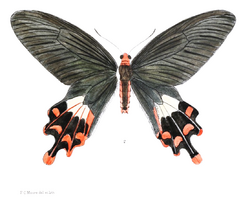Biology:Byasa polla
| De Nicéville's windmill | |
|---|---|

| |
| Specimen from northern Sagaing, Myanmar (upper- and under-side) | |
| Scientific classification | |
| Domain: | Eukaryota |
| Kingdom: | Animalia |
| Phylum: | Arthropoda |
| Class: | Insecta |
| Order: | Lepidoptera |
| Family: | Papilionidae |
| Genus: | Byasa |
| Species: | B. polla
|
| Binomial name | |
| Byasa polla (De Nicéville, 1897)[1]
| |
Byasa polla, the De Nicéville's windmill, is a butterfly found in India that belongs to the windmills genus (Byasa), comprising tailed black swallowtail butterflies with white spots and red submarginal crescents.
Range
It is found in north east India, Myanmar (eastern Bhamo and Bernardmyo of Shan states), northern Thailand, northern Laos and south western China.
In India, it is found in the states of Assam, Arunachal Pradesh, Manipur and the Chin hills in Nagaland.
Status
It is very rare and protected by law in India. More information is needed on the distribution and status.[2]
Description
- Wingspan: 110–130 mm.
- Similar to the rose windmill (Byasa latreillei) but the fringe from tornus to vein 3 is vermilion red and not black.
Male "Very closely resembles B. latreilli male, but judging by a single specimen the fore wing is proportionately rather narrower, the termen more oblique, the tornus more rounded. The markings on the hind wing differ as follows:—the discal white patch composed of four elongate spots in interspaces 2-4, that in interspace 4 very broad, filling the interspace between the middle of veins 5 and 6; subterminal series of lunules larger than in latreilli, and all vermilion-red, not crimson, both on the upper and undersides; cilia between tornus and apex of vein 3, apex of tail and cilia at apex of vein 5 vermilion-red. On the underside, the spot of the discal patch in interspace 1 is vermilion-red, and the red lunule of the subterminal series in interspace 2 is produced to the vermilion-red terminal edging below it. Antennas, head, thorax and abdomen as in P. latreillei."
Female. "Appears to differ only from the male on the upperside of the hind wing in the white patch, which is continued posteriorly to the abdominal margin or nearly so and does not extend into the end of the cell." (de Nicéville, quoted in Bingham)[3]
"This seems to be a very rare insect, at any rate within British territory, only single specimens seem to have been taken so far. Of these, one, a female, now in the British Museum, I took at over 5000 feet elevation, on the shoulder of the hillside on which were built the barracks for the troops at Bernardmyo, in the Ruby Mines district, Upper Burma."[3]
Taxonomy
No separate subspecies have been described.
Habits
Recorded from Manipur to Nagaland in June.
See also
- Papilionidae
- List of butterflies of India
- List of butterflies of India (Papilionidae)
Cited references
- ↑ "Papilionidae – revised GloBIS/GART species checklist (2nd draft)". Entomological Data Information System. Staatliches Museum für Naturkunde Stuttgart, Germany. 28 July 2005. http://www.insects-online.de/frames/papilio.htm. Retrieved 21 June 2013.
- ↑ Collins, N. Mark; Morris, Michael G. (1985). Threatened Swallowtail Butterflies of the World: The IUCN Red Data Book. Gland & Cambridge: IUCN. ISBN 978-2-88032-603-6. https://www.biodiversitylibrary.org/item/98674#page/7/mode/1up.
- ↑ Jump up to: 3.0 3.1 Bingham, C.T. (1907). The Fauna of British India, Including Ceylon and Burma. II (1st ed.). London: Taylor and Francis, Ltd.. https://archive.org/details/butterflies02bingiala.
References
- Evans, W.H. (1932). The Identification of Indian Butterflies (2nd ed.). Mumbai, India: Bombay Natural History Society.
- Haribal, Meena (1992). The Butterflies of Sikkim Himalaya and Their Natural History. Gangtok, Sikkim, India: Sikkim Nature Conservation Foundation.
- Wynter-Blyth, Mark Alexander (1957). Butterflies of the Indian Region. Bombay, India: Bombay Natural History Society. ISBN 978-8170192329. https://books.google.com/books?id=yEkgAQAAMAAJ.
Wikidata ☰ Q4817675 entry
 |


